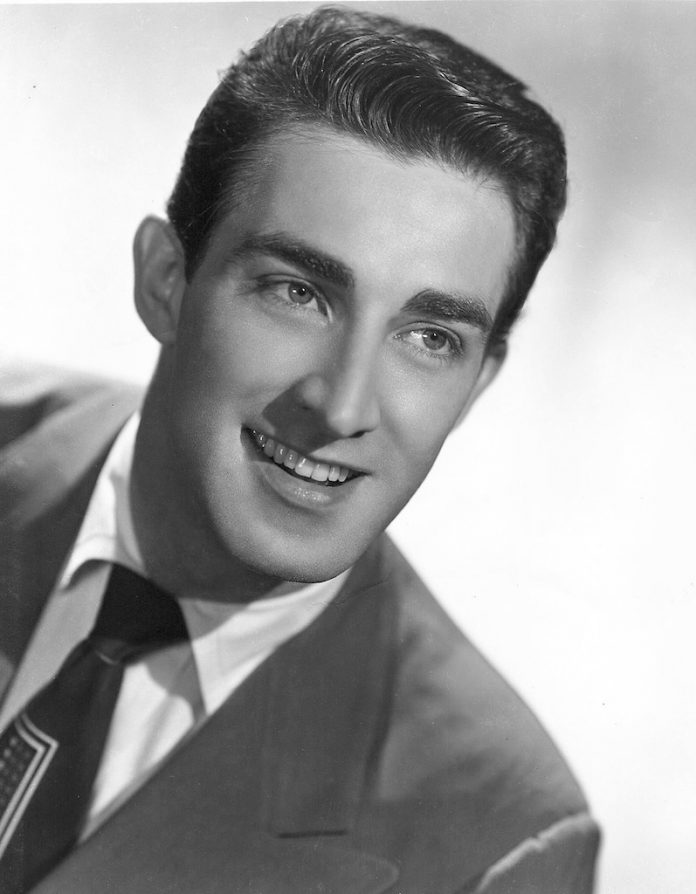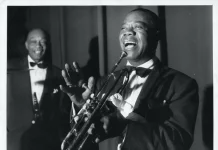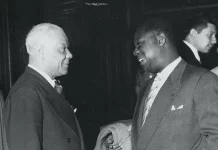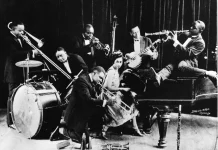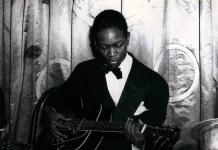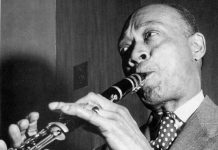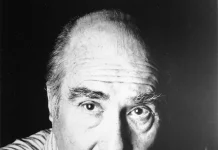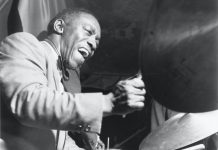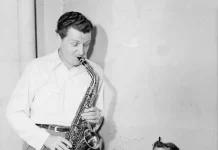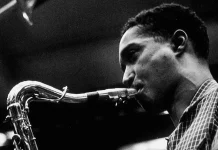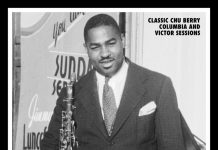Tommy Dorsey liked to have all the “improvised” solos in his numbers concur note-for-note with the originals on his records. One night in the summer of 1946, flouting the rules, Buddy DeFranco changed his solo in a live performance of Opus One. Typically, Tommy suffered a tsunami of rage and afterwards rampaged ready to tear his young virtuoso apart.
“You changed the solo”, Tommy roared. “But Tommy”, said the cowering Buddy, “it’s not artistic to play the same solo every night”.
“Artistic?” roared Tommy. “Artistic! Who d’you think you are, Art Tatum? Go and be artistic on someone else’s band. You’re fired”.
At the end of the next year Buddy was still desperate for work. His friend André Previn wanted to bring him in to the band that he worked in. “Buddy who?” was the question everyone asked. “Tommy has black-listed you”, André told him.
At the end of that year Tommy said “We need a clarinet player in this band”, preparing for the ejection of the incumbent reed man. He contacted DeFranco, who, on his uppers, desperately needed money. When Buddy answered the phone, Tommy used one of his favourite phrases. “Well”, he snarled. “You ready to come back now? You got enough wrinkles in your bag?”
Tommy made Buddy an offer, but Buddy knew you had to ask for much more and particularly for all expenses paid (if you didn’t ask for all expenses paid you wound up paying your own hotel bills when out on the road). Buddy pretended that he had plenty of work and offers of lots more, and needed even more money to make the move to Tommy worthwhile. Tommy grudgingly gave in.
But Buddy was so broke that he had to ask Tommy to advance him his train fare to pick up with the band. “You cheapskate!” roared Tommy. “You’ve been broke and out of work all the time!” He yelled with rage at Buddy for the deception, but Buddy stood up to him. “We made a deal, Tommy. You’ve got to stick to it”.
Tommy was always honest in such matters, and did stick to their original agreement. As did Bing Crosby.
Bing Crosby
Bing, as evinced by his work with the Three Rhythm Boys and by the two fine takes of St Louis Blues with the February 1932 Duke Ellington band, had a fine rhythmic drive, sense of time and a high level of taste that made him one of the best of all scat singers and indeed at that time, one of the most gifted jazz singers. His frequent improvisations were also high class. Both takes of St Louis, incidentally, open with great solos by Cootie, with the one on the “unissued” take being the better.
‘Bing used to have his real friends, people like Cary Grant and Joe Venuti, to stay at his house with him’, Louis said sadly. ‘But he never asked me. I never went to his home. I wonder why?’
Most of Bing’s appearances with the Three Rhythm Boys (Rinker, Barris and Crosby) were jazz performances, even when the backings were rigid and unswinging. It was only in the middle 30s, when Bing’s producers coaxed him away from jazz and in the direction of ballads and even light opera, that we lost him as a potential long-term jazz singer.
Bing’s first major influence had been Mildred Bailey, elder sister of Al Rinker. It was Mildred who told him in the mid 20s that he’d never be a good singer until he’d listened to Louis Armstrong. Bing hadn’t heard Louis and she nagged him continually about Louis (at a time when Louis had made few if any vocal recordings). Eventually, when the Paul Whiteman Orchestra was in Chicago, Whiteman took Bing to the Sunset Cafe and introduced him to Louis. It was the beginning of a lifelong friendship. But it wasn’t necessarily a perfect one.
“Bing used to have his real friends, people like Cary Grant and Joe Venuti, to stay at his house with him”, Louis said sadly. “But he never asked me. I never went to his home. I wonder why?”
Bing had what was almost an obsession with minstrel shows, and often dug out minstrel numbers from the 19th century. He often recreated minstrel shows at his home and in at least one of them he and Venuti blacked up.
Kay Starr
Kay Starr regarded herself as a jazz singer (although she once said “I sing drunks’ music”). Six times married, Kay was still working in public almost up to 2016, the year she died from Altzheimer’s at the age of 94.
With a powerful jazz root and similar sense of timing and rhythm, she engulfed anything from country to pop to powerful blues in her wide range of material. Once she became established and confident with the Charlie Barnet band, her strong personality came through. She did record before that, with the Glenn Miller band in the 30s, but the three tracks I’ve heard show nothing of the great singer that Billie Holiday said was “the only white woman that could sing the blues”.

“People who haven’t seen me either think I’m a 260-pound peroxide blonde or a 260-pound black woman”, Kay Starr told an interviewer in 1981. “Whites sing one-two-three-four. I sing between the beat, in the cracks, any old way”.
If you are an Amazon Prime subscriber, you can listen free to those three tracks with Glenn Miller and indeed another four CDs’ worth in the excellent The Kay Starr Collection 1939-62, which will play through the headphone connection in your PC.
Kay was born on a reservation. Her father was Iroquois and her mother of Iroquois and Irish descent. The family moved to Dallas, where Kay won a radio talent contest when she was seven and as a result was given a 15-minute radio show, By the time she was 15, she was appearing five times a week on radio, and two years later, joined Joe Venuti’s band.
‘I sing things that have a beginning, middle and end. Rock didn’t tell a story, just, “I got you, Babe. I got you, Babe”‘
“If you didn’t know the words, you’d better make them up, because Joe would hit you across the butt with that violin bow, and when I tell you that thing stings, I kid you not”, she recalled.
After a short spell with Bob Crosby’s band, she replaced the ailing Marian Hutton in the Glenn Miller band and during her first week made the recordings mentioned above. By the end of the week Hutton had recovered and demanded and got her job back.
Kay was not best pleased. “My mother and I got back home with literally three cents in our pockets”. Charlie Barnet took her on in 1943, but the cold in the band bus gave her pneumonia and eventually polyps on her vocal chords kept her from singing for a year.
Kay went solo in 1946 and signed with the new Capitol label the following year, benefiting, like Kenton and Billy May, from that company’s supreme recording qualities. She made her breakthrough in 1950 with Bonaparte’s Retreat. She had liked the tune and when she wanted to sing it found that there was no lyric. She persuaded the composer Pee Wee King to write one for her.
She soon developed a huge following and in catering for it left jazz behind to satisfy the hunger for country and western. However, her records were often worth listening to, and she made occasional successful forays back into jazz. Her jazz roots surfaced in a large proportion of her sessions.
Like so many good artists, she was seen off by the advent of rock ’n’ roll.
“I sing things that have a beginning, middle and end”, she said. “Rock didn’t tell a story, just, ‘I got you, Babe. I got you, Babe’. I was too old to be standing up there doing ‘I got you, Babe'”. She remained a very attractive woman into her later years and her career extended well into what other singers would have regarded as very old age. She was still playing gigs and recording albums into her 70s.
She divorced each of her six husbands. She must have been a tough cookie. She died on 3 November 2016.
Palmquist and the Duke
David Palmquist seems to have devoted most of his life to his researches into Duke Ellington’s life. He’s still at it, but a monumental chunk of it appears as The Duke – Where and When, where David has chronicled as much of Duke’s day-by-day life as he can. It’s hard to conceive how much work he’s put into this imposing achievement. An unfortunate result of his intensive labour is serious damage to his eyesight. I try to persuade him to take it easy, but there’s no chance that he will.

